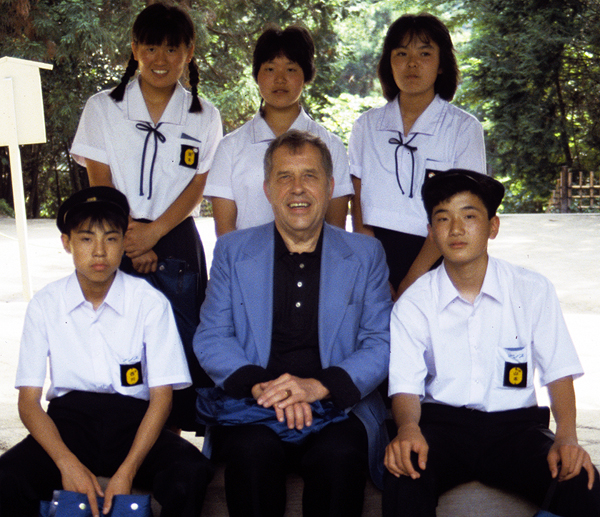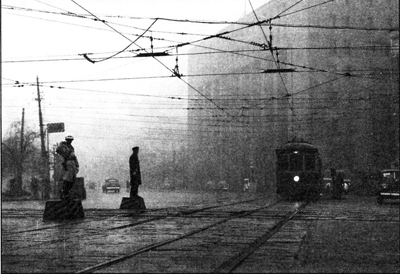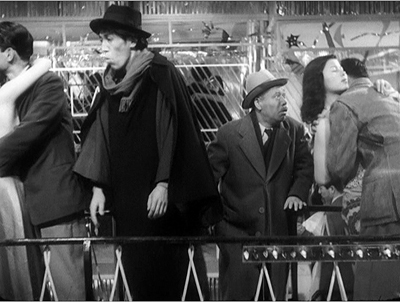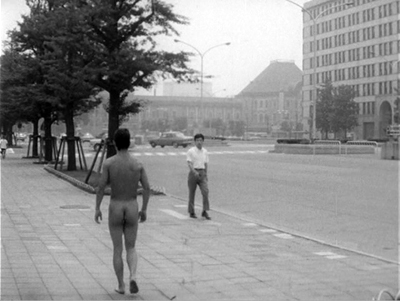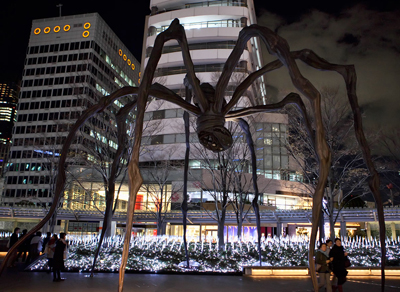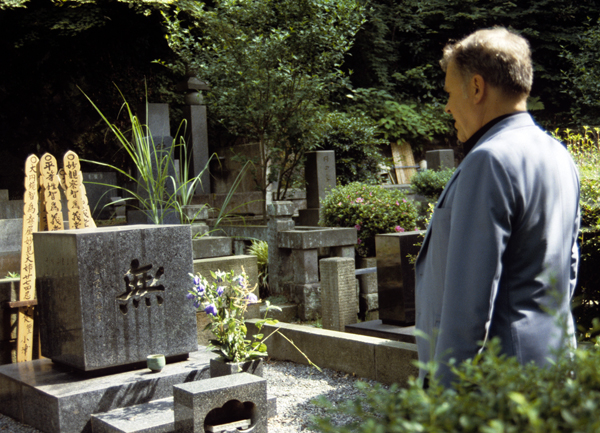Donald Richie and students. Kitakamakura, July 1988. Photo by DB.
DB here:
He died last week, aged 88.
What was his life about? The public dimensions involved, of course, his status as unofficial spokesman, principal gaijin, the gatekeeper and guide to anyone interested in Japan. He hosted grad students as genially as he played tour guide to Truman Capote and Susan Sontag and Jim Jarmusch. I don’t know of any other situation in which an American (from Lima, Ohio, no less) became the spokesperson for a foreign culture. From the 1950s into the 2010s, in a stream of writings and lectures, he interpreted how the Japanese lived, worked, thought, and created. Although he wrote about everything from landscape to tattoos, he became best known as the supreme expert on Japanese cinema. His particular love was the postwar “Golden Age” of the late 1940s through the early 1960s.
Tokyo/Hibiya crossing; Dai-Ichi Building, 1947.
Japan was still terra incognita to Westerners when he came there in 1947. When the outer world demanded to understand this very strange place that had fought so tenaciously against America, there arose a generation of interpreters. Of that cadre, though, he stands out as the man you can’t quite place.
The oldest of the group was Edwin Reischauer [3], who worked largely in international policy. A somewhat younger man, Donald Keene [4], became the dean of Japanese literary studies. Keene has provided translations and magisterial overviews of the Japanese novel, drama, and poetry. An almost exact contemporary of Keene’s is Edward Seidensticker [5], who has been a renowned translator and cultural historian.
Only a little younger was our author, who came to Japan in the Navy and soon became a prolific writer. Yet his work didn’t fit the mold of the other American experts on Japan. He was neither a traditional scholar (he read little Japanese, though he spoke it fluently) nor a pure journalist (he refused to be tied to topicality). He remained resolutely in-between. What academic would have the brass to sum up “The Japanese Way of Seeing” in a seven-page essay? Yet what journalist would write subtle critical monographs on Ozu and Kurosawa?
In my copy of Partial Views: Essays on Contemporary Japan [6], he wrote: “For David, from Donald, particularly pp. 157-205.” On those pages you find his “Notes for a Study on Shohei Imamura.” It’s a fertile survey of recurring themes and techniques in Imamura’s films. In the hands of a professor it could certainly become a tightly argued book. Was his inscription telling me that, when he wanted to, he could execute criticism with an academic accent? If so, it was unnecessary. I didn’t need convincing. I think he could have done whatever he wanted.
What he wanted, I think, was to join the tradition of European belles lettres. He earned his living by writing, and doubtless his championship typing skills steered him toward the quick turnover of daily deadlines. More deeply, I think, he found the shorter piece suited his flair for precise evocation. Even in his books, his approach is essayistic, faceted. His tone—thoughtful but not severe, conversational, projecting wide knowledge and good sense and humane modesty—won the reader by its quiet conviction that the subject was important. This essay wouldn’t be the last word; indeed, he would likely return to the subject years later, testing out new ideas. Much of his output consists of occasion-based pieces, and any of these might be recast, cut, or expanded. A craftsman knows how to recycle scraps and spruce up old projects.
This commitment to fluent reflection on daily changes, along with a quality of seeing everything around him afresh, put him in the tradition of the Continental “man of letters.” He was an aesthete, a moralist, and a bit of a dandy. His natty clothes were like his literary style, crisp and elegant but not flamboyant.
His preferred mode was description. He was convinced that whereas Westerners struggle to probe the depths, “The Japanese realize that the only reality is surface reality.” During a visit to Madison, he was delighted to find a translation of the Goncourt brothers’ journals. I couldn’t help thinking that he took them as a model of the urbane curiosity and pellucid prose he cultivated.
Above all he was interested in people. He was an excellent observer but also a well-tempered listener. He chatted with barbers, students, masseuses, neighbor ladies, potters, delivery boys, executives, and celebrities. He listened to their complaints, their dreams, and their reports on the texture of their lives. Sometimes they quarreled with him or disappointed him. But each one gave him a glimpse of the wavering mirage that was Japan, or at least his Japan.
Ikiru (Kurosawa, 1952).
His writing skills worked on a big canvas in The Japanese Film: Art and Industry (1959) [8]. He wrote the text while his collaborator Joseph Anderson, who read Japanese, provided the research. The book came at just the right moment, when Americans were starting to appreciate the power of this nation’s cinema. To this day, despite many specialized studies of directors, periods, and genres, it remains the standard overview of one of the great national film traditions.
Just as important, for me at least, was The Films of Akira Kurosawa (1968). The first edition, a magnificent buff volume with razor-sharp illustrations and double-column text, is a triumph of book design, as solid and imposing as the films it canvasses. Along with Robin Wood’s works [9] on Hitchcock and Hawks, it showed that cinema could be studied with intellectual seriousness. To the auteurist’s search for the guiding themes of a director’s vision, the Kurosawa book brought a sharp eye for technique and a direct access to the artist himself. (Our author’s first visit to a movie set was to Drunken Angel.) And it proved that a great film could sustain shot-by-shot scrutiny.
Turn to any chapter and you will see a probing intelligence. For Ikiru, we get a detailed layout of image/ sound relations in the nighttown sequence, bracketed by Watanabe’s funeral. The analysis carries us to this conclusion:
He has become much more than simply dead. Just as, dying, he learns to live; so, dead, he becomes more alive for others than he ever was before.
The Kurosawa book remains an exceptional achievement in sympathetic imagination. The critic is so finely in tune with the creator’s sensibility that each chapter illuminates and amplifies the dynamics of the film. There are other ways of understanding Kurosawa, but this book will remain the compass that orients us to this essential director’s career.
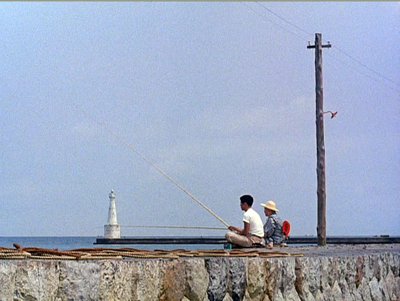
Floating Weeds (Ozu, 1959).
There were other books, of course. Among the best is the rare 1961 Japanese Movies [10], published by the Japan Travel Bureau. It is a compact survey of the major directors working in the postwar era. You sense that its intense aesthetic appreciation of particular films arises from portions cut from The Japanese Film. Here the critic is working at full stretch, and his thoughts on Naruse, Mizoguchi, and others are still worth reading. In its fifteen pages on Ozu, then unknown in the West, lie the seeds of his book on the director.
We have him to thank for our awareness of Ozu. He persuaded the reluctant Shochiku company to release the films in Europe and the US. His ten years of effort were crowned by the release of several Ozu films in New York in 1971-1972. At that point, largely as a result of accidental access, Tokyo Story emerged as the director’s official masterpiece. Soon afterward there appeared Ozu: His Life and Films [11] (1974), another monograph informed by personal acquaintance with the director.
The Kurosawa book dealt in depth with each film, but this took a more horizontal and modular approach, tracing a skein of similarities across Ozu’s work. As one would expect, the emphasis falls on the postwar films, which were more easily available and which the author saw as they were released. (“Revisionist” takes on Ozu, and Japanese cinema as a whole, would soon return to the 1920s and 1930s and find there an earlier Golden Age.) The chapter layout tends to assume that Ozu films are more uniform than they are, but for its attention to themes and script construction in particular Ozu is indispensable. The author’s love for the films shines through every page.
It’s sometimes said that he brought Japanese cinema to the west, but apart from his championing of Ozu, this is inexact. Rashomon opened in New York in 1951, and Gate of Hell won an Academy Award in 1955. Daiei and Toho studios exported several films to Europe and America, while distributor Thomas Brandon sought to bring less-known Kurosawas to the US. The Japanese Film arrived at a propitious moment in 1959, when it could capitalize on the wider circulation of titles. Not until the 1970s was America to see a resurgence of interest in Japanese cinema, thanks to the Ozu releases, the Ozu book,the circulating programs sponsored by the Japan Film Library Council, and the efforts of Daniel Talbot’s New Yorker Films.
Still, our author did something quite important. By talking about Japanese cinema in terms amenable to Western tastes, he integrated it into our film culture. Kurosawa as a robust humanist; Ozu as the serene contemplator of life’s transience: these became familiar figures thanks to his eloquent critical rhetoric. At the same time he retained a sense of their uniqueness, insisting in particular on the irreducible Japaneseness of Ozu’s aesthetic.
Although his major books remained essential for film lovers and film courses, it’s fair to say that he got a second wind in recent decades. He won a wide and keen following with his commentaries and liner essays for Criterion DVD releases of Japanese classics. The outpouring of grief after his death comes in large part from viewers who knew him best as a warm, calm voice talking through scenes of Tokyo Story or When a Woman Ascends the Stair or, surprisingly, Bresson’s Au hasard Balthasar. He adjusted well to the new world of video. He treated it as a new conduit for his commitment to civilized discussion.
Five Filosophical Fables (Richie, 1967).
So much for the public man, writer and speaker and animator of film culture. Another side of him was an intense erotic interest. On your first meeting, he made sure you knew what he found appealing. In the Journals, cruising and pickups blend with a swarm of local details of landscape and custom, although consummations are elided.
I had noticed that his suteteko, being thick cotton, are still damp from the swim, and so I suggest he take them off and hang them on a branch to dry. He does so.
*
Later, in the afternoon, I take a train around the coast. . . .
The juxtapositions between moments of artistic ecstasy and sexual passions give the journals a collage-like snap.
[Hiteki] got into all this ten years or so ago. Has no particular feeling for it but it is now all he knows. . . . Does everything but only, I feel because he does not know what else to do. It apparently means little. Small excitement. . . It represents, I guess, something better than nothing.
6 October 1990. Haydn quartets—the delicious Opus 50. They are made up only of themselves.
The diaries we have are very polished products, the results of much rewriting, and stretches are calculated to render the guilt-free sexiness that the wanderer finds all around him. Consider the finesse of this passage about a visit to Aoshima island:
Later we shop in the empty tourist arcades and buy some beautiful and indecent objects—cups you turn over to discover a coupled couple, an articulated vagina disguised as a shell, and a sake cup with a mushroom-shaped penis attached. One is to suck the sake from the mushroom head.
Some readers expect the Journals to be among the author’s most lasting work. They’re valuable as chronicles of the daily life he observed with sympathetic but dispassionate acuity, but they also record the mind and feelings of a man of Wildean sensitivity wandering among dazzling surfaces that kept his senses, and his libido, ever on the alert.
The surfaces might be rough. The journals record his enjoyment of living near Ueno Park, where the homeless and the prostitutes gather at night. He strolls through them, meeting the occasional cop and seeking, as he puts it, someone who can typify Japan in all its contradictions.
Beautiful and indecent: You can find this mixture in some of the experimental films he made too. The most inoffensive of these, Wargames (1962), was circulated among American film societies during the 1960s, but others are more audacious. In the allegorical satire Five Filosophical Fables (1967) a young man abandons a snooty party, strips to the buff, and strolls smiling through Tokyo streets, past the sea, and into the countryside. Cybele (1968), a documentary of an avant-garde theatre performance, presents an orgiastic rite of sex, degradation, and bloody sacrifice.
Roppongi Hills, Christmas 2010.
He was assailed by bouts of illness across two decades, but he seems never to have lost his buoyancy and spiky wit. He was especially mordant on the New Japan. He notes that the thrusting high-rise apartments of the 1980s bubble offer more for Godzilla to whack. “Originally [he] had to content himself with a mere Diet building.” Manga and the Sony Walkman were very much alike, he maintained. Each offered not visual or aural stimulation but a convenient way to shut oneself off from the ugliness of a money-grubbing society: solitary withdrawal amounted to a critique of contemporary life. With mock pathos he told of a salaryman so preoccupied with talking on his cellphone that a passing subway train snagged him and carried him off, the handset dropped squawking to the platform.
The humor could be self-deprecating. One of our conversations:
DB: I liked The Inland Sea.
DR: I traveled for three months and wrote it in three weeks.
DB: And I read it in three hours.
DR: You took too long.
When asked if he loved Japan, he replied, “That’s complicated . . . I love Tokyo.” Yet by the end of his life, his city had become alien to him. His Japan Journals begin by sketching the vibrant colors of a blasted landscape returning to life.
Winter 1947. Tokyo lies deep under a bank of clouds which move slowly out to sea as the sun climbs higher. Between the moving clouds are sections of the city: the raw gray of whole burned blocks spotted with the yellow of new-cut wood and the shining tile of recent roofs, the reds and browns of sections unburned, the dusty green of barely damaged parks, and the shallow blue of ornamental lakes. In the middle is the palace, moated and rectangular, gray outlined with green, the city stretching to the horizons all around it.
The final entry in the journals is dated nearly sixty years later and records a 2004 trip to his old neighborhood. Tansumachi of 1947 had become the fashionable Roppongi Hills district, “the new Japan—gargantuan, expensive, and wasteful.” A Louise Bourgeois statue looms over the pavement like a tarantula. He recalls the street once named Dragon’s Way and the friend’s house that used to stand at that corner. He knows that his nostalgia must seem tiresome and he acknowledges that rapid change is itself a Japanese tradition, a sort of high-tech version of the Floating World. Yet he cannot resist denouncing the Disneyland that the old place has become. He finds no arresting color or light in this world.
In just a number of years every place will look like it, and this kind of economic expediency will be the rule, as will those cute nods in the direction of retro and trad, that comedy team of contemporary design. Here, under the spider, I look into the future which is already here.
He was well aware of living in-between. Today we might say that he was perpetually “other,” too aesthetically sensitive for a mercantile society, too protective of tradition in a period of lightning change, too gay for straitlaced America, too eccentric and independent-minded for assimilation into his adopted nation. Painful as these tensions must have been, he proudly accepted being fundamentally out of place. At the end of one essay he claims his motto to be that of Hugo of Saint Victor:
The man who finds his homeland sweet is still a tender beginner; he to whom every soil is as his native one is already strong; but he is perfect to whom the entire world is as a foreign land.
Extracts from Richie’s writings come from The Films of Akira Kurosawa [14] (1968 and later editions), A Lateral View [15] (1992), and The Japan Journals [16], ed. Leza Lowitz (2005). Richie’s films are available on DVD as A Donald Richie Film Anthology [17] from Image Forum Video. See also The Donald Richie Reader [18] (2001), ed. Arturo Silva, for a varied collection of pieces, including articles on how he came to write about film, and his lively tour Tokyo: A View of the City [19] (1999), with photos by Joel Sackett. The photo of Tokyo/ Hibiya crossing comes from the Journals, the shot of Roppongi Hills from Tokyofashion.com [20].
For a provocative review of The Japan Journals, see Richard Lloyd Parry’s “Smilingly Excluded.” [21] Kim Hendrickson, who produced Richie’s DVD commentaries, provides a tribute on the Criterion site [22]. A list of his commentaries and liner notes is on this page [23].
For more on how Japanese films came into the United States, see Chapter 6 of Tino Balio, The Foreign Film Renaissance on American Screens, 1946-1973 [24].
Thanks to Tony Rayns [25] for conversations and assistance.
Elsewhere on this site are other Richie-related entries, particularly here [26] and here [27].
P.S. 25 February: Karen Severns has set up a Donald Richie tribute page here [28].
Donald Richie at the grave of Ozu. Kitakamakura, July 1988. Photo by DB.
